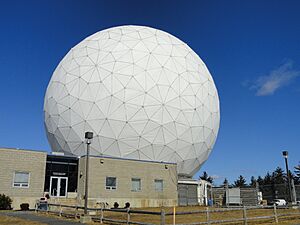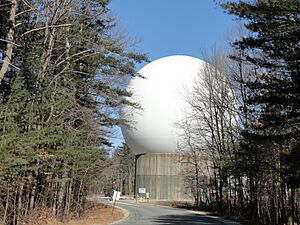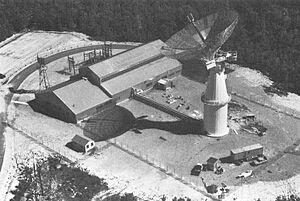Haystack Observatory facts for kids
| Location | Westford, Massachusetts |
|---|
The Haystack Observatory is a special science center owned by Massachusetts Institute of Technology (MIT). It's located in Westford, Massachusetts, about 45 kilometers (28 miles) northwest of Boston. Scientists here use radio waves to study space and Earth's upper atmosphere.
Haystack was first built in 1960 by MIT's Lincoln Laboratory for the United States Air Force. It was known as the Haystack Microwave Research Facility. The main antenna started working in 1964. In 1970, MIT took over the facility. They teamed up with other universities to form the Northeast Radio Observatory Corporation (NEROC) to run it as the Haystack Observatory. Many universities still work together here today.
The Haystack Observatory is also home to the Millstone Hill Geospace Facility, which studies Earth's atmosphere. Lincoln Laboratory still uses part of the site, calling it the Lincoln Space Surveillance Complex. Another observatory, the George R. Wallace Astrophysical Observatory, is nearby. Even a group of amateur telescope makers has their clubhouse on the MIT property.
A valley on the planet Mercury, called Haystack Vallis, is named after this observatory!
Contents
Amazing Telescopes and Radars
Haystack Radio Telescope
The Haystack Radio Telescope is a huge 37-meter (120-foot) dish antenna. It's protected by a 46-meter (150-foot) metal dome called a radome. This telescope is used for tracking objects in space and for talking to spacecraft. But mostly, it's used for studying the universe.
It started working in 1964. Back then, it listened to radio waves at 8 GHz. Since then, it has been updated to listen to many other radio frequencies. When used as a radar, it sends out and listens for radio waves at 10 GHz or 95 GHz. In 2006, the main dish was improved to work at even higher frequencies, up to 150 GHz.
How Haystack Radar Works
The Haystack radar system is called the Long-Range Imaging Radar (LRIR). It was made to take pictures of objects far away using X-band radio waves. It can see details as small as 25 centimeters (10 inches)! This allows it to track and image satellites, even those very far away in geostationary orbit. It can also see objects in deep space up to 40,000 kilometers (25,000 miles) away.
This radar was upgraded to become the Haystack Ultrawideband Satellite Imaging Radar (HUSIR). This new system can work with two different radio bands at the same time: X-band and W-band. This helps scientists better figure out the size, shape, how an object is facing, and how it's moving in space. The HUSIR system can track objects with amazing accuracy. It helps provide data to the United States Space Surveillance Network (SSN), which keeps an eye on objects in space.
Haystack Auxiliary Radar (HAX)
The Haystack Auxiliary Radar, or HAX, is another radar system with a 40-foot (12-meter) dish antenna. It was built in 1993 to help the main Haystack radar. HAX helps collect more information about space objects, including space debris. It also sends data to the SSN.
Westford Radio Telescope
The 18.3-meter (60-foot) Westford Radio Telescope was built in 1961. It was originally part of Project West Ford, an experiment by Lincoln Laboratory. It's located about 1.2 kilometers (0.75 miles) south of the main Haystack telescope. This antenna is inside a 28.4-meter (93-foot) dome.
Since 1981, it has been mainly used for geodetic very long baseline interferometry (VLBI). This is a fancy way of saying it helps measure the Earth very precisely. By looking at distant radio sources in space, scientists can use VLBI to measure tiny changes in Earth's axial tilt, for example.
Event Horizon Telescope Hub
Haystack Observatory is a very important center for the Event Horizon Telescope. This is a huge network of radio telescopes all around the world. They all work together using a technique called very-long-baseline interferometry (VLBI). This allows them to get an incredibly sharp view, sharp enough to take pictures of a supermassive black hole's event horizon.
How does it work? Scientists collect huge amounts of data on large hard drives from all the telescopes. These hard drives are then brought to Haystack. Here, a powerful group of about 800 computers runs special programs to create the black hole images. It's like the computers act as a "silicon lens" because the data from each telescope alone isn't useful. It all has to be combined by the computers to make a picture.
Past Telescopes
The Deuterium Array was a radio telescope that operated from 2004 to 2006. It had 25 parts and was designed to look for radio waves from deuterium, a special type of hydrogen.
Millstone Hill Geospace Facility
The Millstone Hill Geospace Facility is a research center that studies Earth's atmosphere. It's also in Westford, Massachusetts, and is supported by the National Science Foundation. It's part of the larger Haystack Observatory.
Millstone Hill has two of the most famous incoherent scatter radars in the world. These include a 46-meter (150-foot) antenna that can be pointed in any direction, called the Millstone Hill Steerable Antenna (MISA). There's also a 68-meter (223-foot) antenna that points straight up. These radars can measure many things about the ionosphere, which is a part of Earth's upper atmosphere. They can measure things like how many electrons are there, the temperature of the plasma, how fast ions are moving, and what kinds of ions are present. All the data from Millstone Hill is available to the public online through a system called MADRIGAL.
Millstone Hill Steerable Antenna (MISA)
The Millstone Hill Steerable Antenna (MISA) is a 46-meter (150-foot) antenna that can be fully steered. It was built in 1963 and moved to the Haystack Observatory complex in 1978. It's mainly used to study the upper atmosphere using special radar techniques.
Zenith Antenna
The 67-meter (220-foot) Zenith antenna was also built in 1963. It works with a powerful radio transmitter. This antenna points straight up and is used only for incoherent scatter radar observations of the middle part of the ionosphere.
Directors of Haystack Observatory
Many people have led the Haystack Observatory over the years. Paul B. Sebring was the director from 1970 to 1980. John V. Evans took over from 1980 to 1983. Joseph E. Salah was the director from 1983 to 2006. Alan R. Whitney was the temporary director from 2006 to 2008. Colin J. Lonsdale became the director on September 1, 2008.
Images for kids





